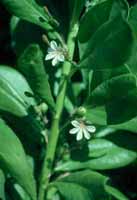|
Description: This woody plant grows to heights of 3 m (10 ft) and has somewhat fleshy leaves 5-20 cm (2-8 in) long, crowded at the tips of the stems. Kōņņat produces many white, five-petaled flowers 1-4 cm (1/2-2 in) long and fleshy, white, roundish fruits 8-15 mm (1/3-2/5 in) long.

|
Uses: People sometimes plant or protect kōņņat because it serves as a windbreak and as an ornamental shrub. Wood from kōņņat furnishes firewood, and the rootstock is shaped into coconut husking sticks. The bark is sometimes mixed with rust scraped from old metal drums and used as a dye on handicraft materials. The flowers are used in garlands or leis; leaves and buds are also mixed with coconut oil to make perfume. Kōņņat is also an important medicinal plant in the Marshall Islands with a number of applications. It has often been used to cure womb illness or given to mothers who have just had a baby. The bitter juice is extracted from pounded leaves squeezed in cloth, mixed with fresh water, and drunk by women. It is believed that this drink will help women to retain their youthful looks and keep their skin healthy. For bathing purposes the leaves are pounded and mixed with grated coconut, strained through cloth, and then added to the bath. To make babies healthy and strong, the fruit and flowers of kōņņat are cooked for about 15 minutes and put into a bath for the infants. Corpses are cleansed with the leaves of kōņņat. Leaves are said to be used as a "psychic energizer" (to help heal people who are under the spell of "black magic"). Sea turtles eat the leaves of kōņņat after laying their eggs, usually under or near this plant. This fact is offered in explanation of prescribing the leaves to women after childbirth. |
Distribution: This widespread native shrub is among the most common plants in the Marshall Islands. It is also the dominant shore plant in the coastal strand vegetation of most tropical Pacific islands, perhaps because it is an early colonizing species (one of the first to grow in open or disturbed places).
 
Close up of the flower & the fruit. |

